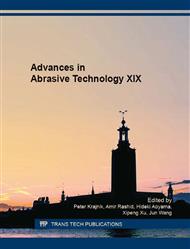[1]
J. Wang, J., Abrasive Waterjet Machining of Engineering Materials, Trans Tech Publications, Uetikon-Zuerich, Switzerland, (2003).
Google Scholar
[2]
T. Nguyen, D.K. Shanmugam, J. Wang, Effect of liquid properties on the stability of an abrasive waterjet. International Journal of Machine Tools and Manufacture, 48 (2008), 1138-1147.
DOI: 10.1016/j.ijmachtools.2008.01.009
Google Scholar
[3]
J. Wang, T. Nguyen, K.L. Pang, Mechanisms of microhole formation on glasses by an abrasive slurry jet, Journal of Applied Physics 105/4 (2009), 044906.
DOI: 10.1063/1.3079802
Google Scholar
[4]
I. Finnie: The mechanism of erosion of ductile metals. Proc. 3rd National Congress of Applied Mechanics, ASME, New York, 1958, pp.527-532.
Google Scholar
[5]
I. M. Hutchings, Deformation of metal surfaces by the oblique impact of square plate. International Journal of Mechanical Sciences, 19 (1977) 45-52.
DOI: 10.1016/0020-7403(77)90015-7
Google Scholar
[6]
J. G. A. Bitter, A study of erosion phenomena, Wear 6 (1963), pp.5-21.
Google Scholar
[7]
J. Wang, Abrasive waterjet machining of polymer matrix composites - Cutting performance, erosive analysis and predictive models, International Journal of Advanced Manufacturing Technology, 15 (1999) 757-768.
DOI: 10.1007/s001700050129
Google Scholar
[8]
J.M. Walsh, G.L. Stradling, G.C. Idzorek, B.P. Shafer, D.O. Wx, H.L. Curling Jr, Microparticle impacts at ultra-high velocities: Their relation to macroparticle impacts, International Journal of Impact Engineering, 14 (1993) 775-784.
DOI: 10.1016/0734-743x(93)90071-e
Google Scholar
[9]
G.R. Johnson, W.H. Cook, A constitutive model and data for metals subjected to large strains, high strain rates and high temperatures, Proc. 7th Int. Symp. Ballistics, Hague, The Netherlands, 1983, pp.541-547.
Google Scholar
[10]
W.Y. Li, J. Wang, H.T. Zhu, H.Z. Li, C.Z. Huang, On ultrahigh velocity micro-particle impact on steels - A single impact study. Wear, 305 (2013) 216-227.
DOI: 10.1016/j.wear.2013.06.011
Google Scholar
[11]
Y. Bao, T. Wierzbicki, On fracture locus in the equivalent strain and stress triaxiality space, International Journal of Mechanical Sciences, 46 (1) (2004) 81-98.
DOI: 10.1016/j.ijmecsci.2004.02.006
Google Scholar
[12]
G.R. Johnson, W.H. Cook, Fracture characteristics of three metals subjected to various strains, strain rates, temperatures and pressures, Engineering Fracture Mechanics, 21 (1) (1985) 31-48.
DOI: 10.1016/0013-7944(85)90052-9
Google Scholar
[13]
D. Macdougall, Determination of the plastic work converted to heat using radiometry, Experimental Mechanics, 40 (3) (2000) 298-306.
DOI: 10.1007/bf02327503
Google Scholar
[14]
V. Babuska, J. Fiala, M. Kumazawa, I. Ohno, Y. Sumino, Elastic properties of garnet solid-solution series, Physics of the Earth and Planetary Interiors, 16 (2) (1978) 157-176.
DOI: 10.1016/0031-9201(78)90086-9
Google Scholar
[15]
D. Arola, M. Ramulu, Material removal in abrasive waterjet machining of metals surface integrity and texture, Wear, 210 (1-2) (1997) 50-58.
DOI: 10.1016/s0043-1648(97)00087-2
Google Scholar
[16]
J. Wang, Particle velocity models for ultra-high pressure abrasive waterjets, Journal of Materials Processing Technology, 209 (9) (2009) 4573-4577.
DOI: 10.1016/j.jmatprotec.2008.10.021
Google Scholar
[17]
D.L. Zou, L. Zhen, C.Y. Xu, W.Z. Shao, Characterization of adiabatic shear bands in AM60B magnesium alloy under ballistic impact, Materials Characterization, 62 (5) (2011) 496-502.
DOI: 10.1016/j.matchar.2011.03.003
Google Scholar
[18]
R.E. Winter, I.M. Hutchings, The role of adiabatic shear in solid particle erosion, Wear, 34 (2) (1975) 141-148.
DOI: 10.1016/0043-1648(75)90060-5
Google Scholar
[19]
W.Y. Li, J. Wang, H.T. Zhu, C.Z. Huang, On ultrahigh velocity micro-particle impact on steels - A multiple impact study, Wear, 309(1-2) (2014) 52-64.
DOI: 10.1016/j.wear.2013.10.011
Google Scholar


